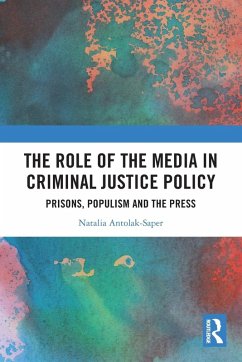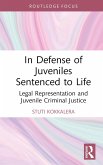Natalia Antolak-Saper
The Role of the Media in Criminal Justice Policy
Prisons, Populism and the Press
Natalia Antolak-Saper
The Role of the Media in Criminal Justice Policy
Prisons, Populism and the Press
- Broschiertes Buch
- Merkliste
- Auf die Merkliste
- Bewerten Bewerten
- Teilen
- Produkt teilen
- Produkterinnerung
- Produkterinnerung
This book provides a socio-legal examination of the mediaâ s influence on the development and implementation of criminal justice policy.
Andere Kunden interessierten sich auch für
![Homicide in Criminal Law Homicide in Criminal Law]() Homicide in Criminal Law58,99 €
Homicide in Criminal Law58,99 €![Femicide, Criminology and the Law Femicide, Criminology and the Law]() Hava DayanFemicide, Criminology and the Law42,99 €
Hava DayanFemicide, Criminology and the Law42,99 €![Life Without Parole Life Without Parole]() Ross KleinstuberLife Without Parole152,99 €
Ross KleinstuberLife Without Parole152,99 €![In Defense of Juveniles Sentenced to Life In Defense of Juveniles Sentenced to Life]() Stuti KokkaleraIn Defense of Juveniles Sentenced to Life55,99 €
Stuti KokkaleraIn Defense of Juveniles Sentenced to Life55,99 €![Crime and Control in China Crime and Control in China]() BÃ rge BakkenCrime and Control in China22,99 €
BÃ rge BakkenCrime and Control in China22,99 €![Life Without Parole Life Without Parole]() Ross KleinstuberLife Without Parole41,99 €
Ross KleinstuberLife Without Parole41,99 €![Autism and Criminal Justice Autism and Criminal Justice]() Autism and Criminal Justice68,99 €
Autism and Criminal Justice68,99 €-
-
-
This book provides a socio-legal examination of the mediaâ s influence on the development and implementation of criminal justice policy.
Produktdetails
- Produktdetails
- Verlag: Taylor & Francis Ltd
- Seitenzahl: 268
- Erscheinungstermin: 27. Mai 2024
- Englisch
- Abmessung: 234mm x 156mm x 15mm
- Gewicht: 408g
- ISBN-13: 9781032115276
- ISBN-10: 1032115270
- Artikelnr.: 70368204
- Herstellerkennzeichnung
- Libri GmbH
- Europaallee 1
- 36244 Bad Hersfeld
- gpsr@libri.de
- Verlag: Taylor & Francis Ltd
- Seitenzahl: 268
- Erscheinungstermin: 27. Mai 2024
- Englisch
- Abmessung: 234mm x 156mm x 15mm
- Gewicht: 408g
- ISBN-13: 9781032115276
- ISBN-10: 1032115270
- Artikelnr.: 70368204
- Herstellerkennzeichnung
- Libri GmbH
- Europaallee 1
- 36244 Bad Hersfeld
- gpsr@libri.de
Dr Natalia Antolak-Saper is a Senior Lecturer in the Faculty of Law at Monash University, Melbourne, Australia.
List of illustration
Acknowledgements
1 Introduction
I Introduction
II The Approach Adopted
A Theoretical Framework
B Case Study
1 Data Collection for the Case Study
2 Method of Analysis
C Interviews
III Terminology
IV The Structure of the Book
2 Penal Populism
I Introduction
II What Is Penal Populism?
III Conditions Contributing to the Rise of Penal Populism
A Public Opinion
B Media
C Emotion
IV The Effect of Penal Populism on Sentencing Laws and Practice
V Conclusion
3 Media as Agenda Setter
I Introduction
II The Role of the Media in Policy
III Media as Agenda Setter
A Campaigning
1 Media as Advocate
2 Media and Stakeholders
B Framing
1 Faulty System
2 Social Breakdown
3 Blocked Opportunities
4 Media Violence and Racist System
C Fear of Crime and Moral Panics
1 Concern
2 Hostility
3 Consensus
4 Disproportion
5 Volatility
IV Conclusion
4 Media as a Reflection of Public Opinion
I Introduction
II Crime as News Content
III 'News Values'
A Immediacy
B Dramatisation
C Personalisation
D Simplification
E Titillation
F Conventionalism
G Structured Access
H Novelty
I Risk
J Sex
K Proximity
L Violence
M Spectacle and Graphic Imagery
N Children
IV Conclusion
5 Parole
I Introduction
II Parole and Sentencing in Victoria
A Truth in Sentencing
III The History of Parole Reforms
A Parole in Victoria: 1901-2011
B Historical Media Interest in Parole
C Parole Reforms: Balancing Prisoner Interests with Safety to the Community
IV Changes to Parole From 2011 to 2013
A R v Bayley
V Parole: 2013 to Current Day
VI Conclusion
6 Case Study: Adrian Bayley, the Media and the Reform of Parole Law and
Practice
I Introduction
II Media as Agenda Setter
A Campaigns and the Media as Advocate
(a) Media as Advocate
(b) Media and Stakeholders
B Framing
C Fear of Crime and Moral Panics
(a) Concern
(b) Hostility and Consensus
(c) Disproportion
(d) Volatility
(e) Conclusion
III Media as a Source of Information
A 'News Values'
(a) Immediacy
(b) Dramatisation
(c) Personalisation
(d) Simplification
(e) Structured Access
(f) Proximity
(g) Violence, Spectacle and Graphic Imagery
(h) Conclusion
IV Conclusion
7 Conclusion
I Introduction
II The Media's Influence on Sentencing and Parole Policies
III Parole Reforms Post-Adrian Bayley in Practice
IV Moderating the Media's Influence on Sentencing and Parole Policies
A Addressing Misinformation
(a) Informed Public Opinion
B Institutionalising Public Opinion
(a) Introduction
(b) Public Opinion and Sentencing Reform
V Where to from Here? Areas for Further Research
VI Conclusion
Appendix 1: Newspaper Coding Sheet
Appendix 2: Parliamentary Debates Coding Sheet
Appendix 3: Interview Questions
I Senior Politicians
For those not directly involved in the Adrian Bayley Case
For those directly involved in the Adrian Bayley Case
II Senior Policymakers
For those not directly involved in the Adrian Bayley Case
For those directly involved in the Adrian Bayley Case
III Journalists
For Herald Sun journalists specifically
For The Age journalists specifically
Appendix 4: Human Ethics Certificate of Approval
Human Ethics Certificate of Approval
Bibliography
Index
Acknowledgements
1 Introduction
I Introduction
II The Approach Adopted
A Theoretical Framework
B Case Study
1 Data Collection for the Case Study
2 Method of Analysis
C Interviews
III Terminology
IV The Structure of the Book
2 Penal Populism
I Introduction
II What Is Penal Populism?
III Conditions Contributing to the Rise of Penal Populism
A Public Opinion
B Media
C Emotion
IV The Effect of Penal Populism on Sentencing Laws and Practice
V Conclusion
3 Media as Agenda Setter
I Introduction
II The Role of the Media in Policy
III Media as Agenda Setter
A Campaigning
1 Media as Advocate
2 Media and Stakeholders
B Framing
1 Faulty System
2 Social Breakdown
3 Blocked Opportunities
4 Media Violence and Racist System
C Fear of Crime and Moral Panics
1 Concern
2 Hostility
3 Consensus
4 Disproportion
5 Volatility
IV Conclusion
4 Media as a Reflection of Public Opinion
I Introduction
II Crime as News Content
III 'News Values'
A Immediacy
B Dramatisation
C Personalisation
D Simplification
E Titillation
F Conventionalism
G Structured Access
H Novelty
I Risk
J Sex
K Proximity
L Violence
M Spectacle and Graphic Imagery
N Children
IV Conclusion
5 Parole
I Introduction
II Parole and Sentencing in Victoria
A Truth in Sentencing
III The History of Parole Reforms
A Parole in Victoria: 1901-2011
B Historical Media Interest in Parole
C Parole Reforms: Balancing Prisoner Interests with Safety to the Community
IV Changes to Parole From 2011 to 2013
A R v Bayley
V Parole: 2013 to Current Day
VI Conclusion
6 Case Study: Adrian Bayley, the Media and the Reform of Parole Law and
Practice
I Introduction
II Media as Agenda Setter
A Campaigns and the Media as Advocate
(a) Media as Advocate
(b) Media and Stakeholders
B Framing
C Fear of Crime and Moral Panics
(a) Concern
(b) Hostility and Consensus
(c) Disproportion
(d) Volatility
(e) Conclusion
III Media as a Source of Information
A 'News Values'
(a) Immediacy
(b) Dramatisation
(c) Personalisation
(d) Simplification
(e) Structured Access
(f) Proximity
(g) Violence, Spectacle and Graphic Imagery
(h) Conclusion
IV Conclusion
7 Conclusion
I Introduction
II The Media's Influence on Sentencing and Parole Policies
III Parole Reforms Post-Adrian Bayley in Practice
IV Moderating the Media's Influence on Sentencing and Parole Policies
A Addressing Misinformation
(a) Informed Public Opinion
B Institutionalising Public Opinion
(a) Introduction
(b) Public Opinion and Sentencing Reform
V Where to from Here? Areas for Further Research
VI Conclusion
Appendix 1: Newspaper Coding Sheet
Appendix 2: Parliamentary Debates Coding Sheet
Appendix 3: Interview Questions
I Senior Politicians
For those not directly involved in the Adrian Bayley Case
For those directly involved in the Adrian Bayley Case
II Senior Policymakers
For those not directly involved in the Adrian Bayley Case
For those directly involved in the Adrian Bayley Case
III Journalists
For Herald Sun journalists specifically
For The Age journalists specifically
Appendix 4: Human Ethics Certificate of Approval
Human Ethics Certificate of Approval
Bibliography
Index
List of illustration
Acknowledgements
1 Introduction
I Introduction
II The Approach Adopted
A Theoretical Framework
B Case Study
1 Data Collection for the Case Study
2 Method of Analysis
C Interviews
III Terminology
IV The Structure of the Book
2 Penal Populism
I Introduction
II What Is Penal Populism?
III Conditions Contributing to the Rise of Penal Populism
A Public Opinion
B Media
C Emotion
IV The Effect of Penal Populism on Sentencing Laws and Practice
V Conclusion
3 Media as Agenda Setter
I Introduction
II The Role of the Media in Policy
III Media as Agenda Setter
A Campaigning
1 Media as Advocate
2 Media and Stakeholders
B Framing
1 Faulty System
2 Social Breakdown
3 Blocked Opportunities
4 Media Violence and Racist System
C Fear of Crime and Moral Panics
1 Concern
2 Hostility
3 Consensus
4 Disproportion
5 Volatility
IV Conclusion
4 Media as a Reflection of Public Opinion
I Introduction
II Crime as News Content
III 'News Values'
A Immediacy
B Dramatisation
C Personalisation
D Simplification
E Titillation
F Conventionalism
G Structured Access
H Novelty
I Risk
J Sex
K Proximity
L Violence
M Spectacle and Graphic Imagery
N Children
IV Conclusion
5 Parole
I Introduction
II Parole and Sentencing in Victoria
A Truth in Sentencing
III The History of Parole Reforms
A Parole in Victoria: 1901-2011
B Historical Media Interest in Parole
C Parole Reforms: Balancing Prisoner Interests with Safety to the Community
IV Changes to Parole From 2011 to 2013
A R v Bayley
V Parole: 2013 to Current Day
VI Conclusion
6 Case Study: Adrian Bayley, the Media and the Reform of Parole Law and
Practice
I Introduction
II Media as Agenda Setter
A Campaigns and the Media as Advocate
(a) Media as Advocate
(b) Media and Stakeholders
B Framing
C Fear of Crime and Moral Panics
(a) Concern
(b) Hostility and Consensus
(c) Disproportion
(d) Volatility
(e) Conclusion
III Media as a Source of Information
A 'News Values'
(a) Immediacy
(b) Dramatisation
(c) Personalisation
(d) Simplification
(e) Structured Access
(f) Proximity
(g) Violence, Spectacle and Graphic Imagery
(h) Conclusion
IV Conclusion
7 Conclusion
I Introduction
II The Media's Influence on Sentencing and Parole Policies
III Parole Reforms Post-Adrian Bayley in Practice
IV Moderating the Media's Influence on Sentencing and Parole Policies
A Addressing Misinformation
(a) Informed Public Opinion
B Institutionalising Public Opinion
(a) Introduction
(b) Public Opinion and Sentencing Reform
V Where to from Here? Areas for Further Research
VI Conclusion
Appendix 1: Newspaper Coding Sheet
Appendix 2: Parliamentary Debates Coding Sheet
Appendix 3: Interview Questions
I Senior Politicians
For those not directly involved in the Adrian Bayley Case
For those directly involved in the Adrian Bayley Case
II Senior Policymakers
For those not directly involved in the Adrian Bayley Case
For those directly involved in the Adrian Bayley Case
III Journalists
For Herald Sun journalists specifically
For The Age journalists specifically
Appendix 4: Human Ethics Certificate of Approval
Human Ethics Certificate of Approval
Bibliography
Index
Acknowledgements
1 Introduction
I Introduction
II The Approach Adopted
A Theoretical Framework
B Case Study
1 Data Collection for the Case Study
2 Method of Analysis
C Interviews
III Terminology
IV The Structure of the Book
2 Penal Populism
I Introduction
II What Is Penal Populism?
III Conditions Contributing to the Rise of Penal Populism
A Public Opinion
B Media
C Emotion
IV The Effect of Penal Populism on Sentencing Laws and Practice
V Conclusion
3 Media as Agenda Setter
I Introduction
II The Role of the Media in Policy
III Media as Agenda Setter
A Campaigning
1 Media as Advocate
2 Media and Stakeholders
B Framing
1 Faulty System
2 Social Breakdown
3 Blocked Opportunities
4 Media Violence and Racist System
C Fear of Crime and Moral Panics
1 Concern
2 Hostility
3 Consensus
4 Disproportion
5 Volatility
IV Conclusion
4 Media as a Reflection of Public Opinion
I Introduction
II Crime as News Content
III 'News Values'
A Immediacy
B Dramatisation
C Personalisation
D Simplification
E Titillation
F Conventionalism
G Structured Access
H Novelty
I Risk
J Sex
K Proximity
L Violence
M Spectacle and Graphic Imagery
N Children
IV Conclusion
5 Parole
I Introduction
II Parole and Sentencing in Victoria
A Truth in Sentencing
III The History of Parole Reforms
A Parole in Victoria: 1901-2011
B Historical Media Interest in Parole
C Parole Reforms: Balancing Prisoner Interests with Safety to the Community
IV Changes to Parole From 2011 to 2013
A R v Bayley
V Parole: 2013 to Current Day
VI Conclusion
6 Case Study: Adrian Bayley, the Media and the Reform of Parole Law and
Practice
I Introduction
II Media as Agenda Setter
A Campaigns and the Media as Advocate
(a) Media as Advocate
(b) Media and Stakeholders
B Framing
C Fear of Crime and Moral Panics
(a) Concern
(b) Hostility and Consensus
(c) Disproportion
(d) Volatility
(e) Conclusion
III Media as a Source of Information
A 'News Values'
(a) Immediacy
(b) Dramatisation
(c) Personalisation
(d) Simplification
(e) Structured Access
(f) Proximity
(g) Violence, Spectacle and Graphic Imagery
(h) Conclusion
IV Conclusion
7 Conclusion
I Introduction
II The Media's Influence on Sentencing and Parole Policies
III Parole Reforms Post-Adrian Bayley in Practice
IV Moderating the Media's Influence on Sentencing and Parole Policies
A Addressing Misinformation
(a) Informed Public Opinion
B Institutionalising Public Opinion
(a) Introduction
(b) Public Opinion and Sentencing Reform
V Where to from Here? Areas for Further Research
VI Conclusion
Appendix 1: Newspaper Coding Sheet
Appendix 2: Parliamentary Debates Coding Sheet
Appendix 3: Interview Questions
I Senior Politicians
For those not directly involved in the Adrian Bayley Case
For those directly involved in the Adrian Bayley Case
II Senior Policymakers
For those not directly involved in the Adrian Bayley Case
For those directly involved in the Adrian Bayley Case
III Journalists
For Herald Sun journalists specifically
For The Age journalists specifically
Appendix 4: Human Ethics Certificate of Approval
Human Ethics Certificate of Approval
Bibliography
Index









